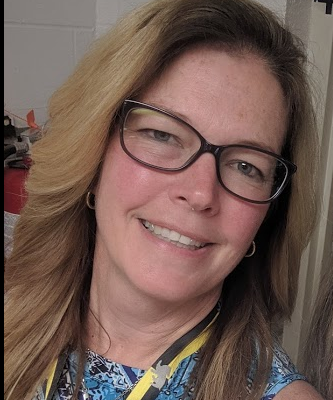By- Cathy Collins and Lori Ayotte
An expanded version of this article titled “Using Short Videos to Enhance Reading and Writing in the ELA Curriculum” appeared in the January 2017 issue of English Journal (Volume 106, Number 3, pp. 19-24). Copyright 2017 by the National Council of Teachers of English. Used with permission.
“Three R’s are no longer enough. Our world is changing fast – faster than we can keep up with through our historical modes of thinking and communicating. Visual literacy – the ability to both read and write visual information; the ability to learn visually; to think and solve problems in the visual domain, …is a requirement for success in business and in life.”
-Dave Gray, founder of visual thinking company XPLANE
Using Short Videos to Enhance Reading and Writing in the ELA Curriculum
Envision reading Wilfred Owen’s haunting antiwar poem, “Dulce et Decorum Est” against the musical backdrop of John Lennon’s quixotic “Imagine.” Consider the emotional effect of Lennon’s lyrics, “Imagine there’s no countries / It isn’t hard to do / Nothing to kill or die for / And no religion too / Imagine all the people / Living life in peace” juxtaposed with Owen’s advice not to “tell with such high zest / To children ardent for some desperate glory, / The old Lie of dying with honor for one’s country.” Owen and Lennon may have produced their greatest works some 50 years apart, but their messages are similar; one writes as a soldier in World War I, and the other writes as an activist songwriter during the height of the Vietnam War. How poignant to consider that both men died tragically before their time, Owen by a machine gun and Lennon by a troubled gunman.
Now imagine the juxtaposition of Owen’s poem and Lennon’s song produced in a short video. As the audience reads Owen’s words and hears Lennon’s lyrics, historic photographs from World War I and the Vietnam War flash on screen. This video presents a new way for readers and listeners to understand Owen’s poem, Lennon’s song, and significant moments in world history. The compilation evokes several themes, including man’s inhumanity to man and the horror and fruitlessness of war.
Value of Visual Literacy in the ELA Curriculum
The digital video experience that created a new story of Lennon’s song and Owen’s poem is one example of how students can illustrate their comprehension of traditional texts; their new animated creations, additionally, offer fascinating reinterpretations of these classic works. Such combinations of text, music, and images are consistent with what the NCTE calls “21st century literacies.” According to a position statement updated in 2013, the NCTE contends that “Active, successful participants in this 21st century global society must be able to
- develop proficiency and fluency with the tools of technology;
- build intentional cross-cultural connections and relationships with others so to pose and solve problems collaboratively and strengthen independent thought;
- design and share information for global communities to meet a variety of purposes;
- manage, analyze, and synthesize multiple streams of simultaneous information;
- create, critique, analyze, and evaluate multimedia texts; and
- attend to the ethical responsibilities required by these complex environments.” (http://www.ncte.org/positions/statements/21stcentdefinition)
Just as textual literacy cannot be restricted to the English classroom, visual and other new literacies cannot be limited to the arts classroom. Since much of our newest technologies are dominated by visuals, we would short-change our students if we didn’t help them think critically about the image-driven messages they receive on a daily basis. Moreover, we would fail them if we did not aid them in effectively and purposely creating their own image-driven messages.
Perhaps there is no more prominent advocate of new literacies than American filmmaker George Lucas, who insists in “Life on the Screen: Visual Literacy in Education” that all forms of communication skills thoroughly be taught. He states:
Today we work with the written or spoken word as the primary form of communication. But we also need to understand the importance of graphics, music and cinema, which are just as powerful and in some ways more deeply intertwined with young people’s culture. We live and work in a visually sophisticated world, so we must be sophisticated in using all the forms of communication, not just the written word.
A perfect venue to teach these new literacies is the English Language Arts classroom, as digital technology becomes incorporated into reading comprehension and writing instruction; with the addition of art and music, students can also incorporate these genres into storytelling components. As Lucas says, these media are all forms of communication.
As Suzanne M. Miller, Merridy A. Knips, and Stephen Goss assert in a 2013 English Journal article, “Like written composing, digital compositions can serve as a means of learning and provide examples of authentic assessment of learning beyond only linguistic assessment” (89). As an ELA teacher and an instructional media specialist, our focus with digital videos builds on that philosophy, using this medium to help students build interdisciplinary connections, to enhance analytical skills, to encourage synthesis of knowledge, to understand how to use technology effectively, and to hone writing skills. We have used digital videos both to analyze poetry and to teach writing strategies, including tone, imagery, and economy of language. However, in our research and brainstorming, we have discovered many uses for digital video technology: presenting outside reading through book trailers, highlighting the history of a time period, modifying an assignment for ELL and special education students, accompanying a personal narrative or a memoir, presenting a research project, advertising for a club, and even to celebrate friends and colleagues.
The tool we repeatedly have turned to is Animoto, a web-based application that allows users without technical video production experience to easily create quality films. The process, which still allows for creativity, is simply a matter of matching up images with text and sound. Educator accounts are available so that as many as 50 students under one classroom promotional code, which spans for six months, may make videos.
Animoto provides users video templates of certain themes: some are seasonal (a winter background, for example, is perfect for showcasing Robert Frost’s “Stopping by the Woods on a Snowy Evening”); others are based on love or nostalgia (perfect for Petrarchan or Shakespearean sonnets); still others are neutral. Adding songs is as simple as browsing through Animoto’s music library, which includes classical, country, hip hop, children’s, Latin, oldies, and pop, among other genres. To add pictures and videos, Animoto has several collections, from travel to animal stock photos. Animoto also provides easy links to Facebook and Instagram to add photos, which can be uploaded from a computer desktop in addition to these social media sites. And, although it is easy to add text, space is extremely limited, much shorter even than the length of one Tweet per slide. Animoto allows, at max, 40 characters on a top line and 50 characters on a bottom line – 90 characters in all per slide.
As useful and as engaging as it is educationally, Animoto – and for that matter, digital video in general – should be used as a tool and not as an end. Its multimedia capabilities encourage students to become more proficient in new literacies as well as new technologies; its limited textual space encourages students to write shorter and smarter, to achieve an emotional or informative effect; and its easy template to add photos, videos and music encourages students to become familiar with fair use/copyright issues.
Influences on reading
Poetry videos
The idea to use Animoto to combine poetry and video evolved out of ELA teacher Lori Ayotte’s creative writing class, which was a starting poetry unit. Many students polled in the class responded that they did not enjoy poetry. Lori made time for students to explore their own poetic interests. That involved media specialist Cathy Collins providing a slew of poetry books ranging from Marge Piercy and Maya Angelou to Robert Frost and Walt Whitman to several poetry anthologies.
One student, a high school senior with a natural flair for writing and an autism disorder, told Lori that he could not pick a poem. “I hate poetry,” he said. Lori wasn’t sure how to respond to his seemingly adamant stance, but she knew she had to break down his resistance. Almost miraculously, her eyes fell upon the Shel Silverstein book Where the Sidewalk Ends, a compilation of childish poems over which even the most hard-hearted high school student waxes nostalgic.
Silverstein’s book was magic. Her student’s eyes lit up, and he smiled widely. He couldn’t stop reading. Now that Lori had all her students’ buy-in, it was time for them to share the poems with their fellow classmates. Twenty students reading poems out loud, however, could be monotonous, so she sought a more engaging presentation medium. In addition, although she aimed for students to engage in some kind of poem analysis, she did not want this task to be something that they would do in a typical English class. She also knew she wanted them to focus on tone, imagery, and rhythm.
Creating poetry videos through Animoto seemed the right answer to maintain the magic that had already begun. Lori was familiar with Animoto because she had used it for several years with Cathy as a story pitch project. By putting images to the poem, students would understand imagery. By choosing a song, they would hear the musicality of the poetry. Students also had to decide on an atmospheric mood through the music and pictures; hence, tone. Monotony was no longer an issue.
Poet choices ranged from Maya Angelou to Walt Whitman to Shel Silverstein. Lori’s two favorite videos included Shel Silverstein’s “Pancake?,” accompanied by the entertaining songs “Bacon Pancakes” and “Tumbling Down” – the latter being appropriate because that’s exactly what happens to the stack of pancakes at the end of the poem. The most beautiful video, arguably, depicted “Bus Stop” by Donald Justice – accompanied by images of rain, darkness, and candles, and set to a New Age soundtrack.
The success of this project made Lori reconsider her teaching of sonnets with her standard-level sophomore class. Thanks to her experience with the autistic high school senior who hated poetry, Lori realized how much students with disabilities and and ELL learners could particularly benefit from this differentiated form of instruction. A 14-line sonnet would provide the perfect length to showcase a poem through a short video.
Again, student choice played an important role. Lori provided her students with several sonnet possibilities, including Robert Frost’s “Acquainted With the Night,” John Keats’s “Bright Star,” Edna St. Vincent Millay’s “Love Is Not All,” Edmund Spencer’s “I Wrote Her Name Upon the Strand,” and Robert Hayden’s “Those Winter Sundays.” The next step was for the students to analyze their chosen poem, applying what they already had learned about sonnets in class: summarizing the stanzas; identifying the turning point; the rhyme scheme; the resolution; and identifying figurative language, imagery and tone.
Once students had analyzed the sonnets and checked in with Lori to be sure they were on track, they began to produce their videos. Students were allowed to work individually or in groups of up to four people. Their task was to ensure that the choice of images and music enhanced the experience and meaning of the original poem. After they completed their videos, they wrote a 1-page written explanation. Each video was shared with the class.
Lori’s favorite explanation came from a former ELL sophomore who was still struggling with writing in English. The girl had chosen perhaps the most difficult poem of the list, “Bright Star.” It was clear by her written explanation that she paid close attention to the meanings of each word and ensured that the right images corresponded in her video. The student wrote, “The second picture I choose is a bluish background picture with a word ‘Faith’, because in the first line the author uses ‘stedfast’ which means faithful. . . . . For the next three pictures, I choose one keyword from each line and find a picture represent them, which the infinite symbol represents eternality, a picture of the Christian hermit which is also eremite, and the spring water as ‘the moving water.’ The seashore is relating to ‘pure ablution’ and the heart shape lock represents ‘unchangeable.’”
Much like Miller, Knips and Goss found with their research on student use of digital video, Lori found on the whole that “diverse students, including many who struggled in school, learned new ways of engaging literature, performing meaning, and thinking symbolically through multimodal translations of the text” (89). Therefore, the following academic year, Lori tried a similar project with her Foundations class, a group of six boys, several of whom are autistic. One boy, Kevin, chose Jack Kerouac’s “43rd Chorus,” which is merely one line, “Abraham, I didn’t write this right.” It was a poor poem choice for the project because it provided no imagery with which to work. Despite Lori’s and a co-teacher’s efforts to persuade Kevin to find an alternate poem, he was reluctant: he was set on using this particular verse, perhaps because it was so short that he would not have to do much. So instead, Lori and her co-teacher chose to make this a teachable moment. They asked Kevin about who Abraham might be: are there any famous Abrahams he was aware of? Abraham Lincoln was Kevin’s first association, and after some prodding, Kevin came up with the Old Testament Abraham, too. So that exercise led Kevin to produce a video that was rich in allusions to the Bible and to American History. Kevin got excited. “I never realized that that’s what the poem might be talking about,” he said. Now, Kevin is very familiar with the concept of allusions, which is one of the literary devices students often overlook.
Influences on writing
Digital videos can help students’ writing as well as reading comprehension. When Lori and Cathy initially experimented with Animoto, it was to enhance a writing assignment in Lori’s Creative Writing class. The students had just written 3-5 page short stories; Lori wanted them to then learn the art of writing a pitch letter to “sell” their stories in the hopes of teaching them persuasive writing and concision of language. Lori then realized that the same skills could be taught through digital video, in addition to reinforcing the concepts of imagery and tone. Cathy had previously discussed the possibility of using digital video as a novel form of book report –creating a movie trailer to get students excited to read a new book. In the revamped assignment, the new book was a student’s own short story.
Since the text was limited per slide, students had no choice but to be creative to fit their meaning to a small amount of space, an excellent exercise in word choice. They also had to consider how their chosen images and sound would be received by an audience.
Best by far was Deepika’s film, which featured a haunted house and the opening line: “She lived alone in silence and solitude / There was no one there to hear her scream.” The foreboding music she chose combined a high-pitched trill and a deep, ominous base; the images consisted of solitary women, mists, bare trees, and ghostly figures. As students watched the video when it was presented in class, they applauded vigorously and commented how much the spooky music and the images unsettled them. Deepika’s film was a success.
Next Steps
Cathy and Lori offered a professional development workshop to district teachers in the middle school and high school so that educators could experiment with this teaching tool. When introduced to the program, teachers repeatedly remarked how easy it was to use.
The teachers made their own digital creations. A freshman ELA teacher created an Animoto video of a Romeo and Juliet soliloquy to teach oxymoron: “O serpent heart hid with a flowering face! / Did ever dragon keep so fair a cave? / Beautiful tyrant! Fiend angelical!” (Shakespeare 3.2.74-76). A middle school teacher showcased the T.S. Eliot poem, “The Hollow Men” photographs of WW1 in a poignant requiem set to Beethoven’s Moonlight Sonata. Lori played this video for her sophomore students while they were studying All Quiet On The Western Front, and then she thought of how these videos could help students integrate aspects of history and literature. Follow up PD workshops are being planned for “Lunch and Learn” sessions in the library and as part of a district-wide PD day with a focus on technology integration.
From collaborative planning of PD for teachers to project ideas for “Tech Help Desk” students who are housed in the library, new digital literacy and technology tools are showcased and incorporated across curriculum areas. Last April, for example, in celebration of School Library Month, students and staff were invited to tweet “Selfies” and creative video clips of their favorite books along with the reasons why they were recommending specific titles to the Sharon High School Library’s Twitter handle (@SHS_LibraryMA) and Facebook page. As a way to engage students and staff with books and with each other, the project has proved successful in terms of numbers of participants and range of creative submissions. The project is just one more example of a simple yet meaningful way to give students practice in combining words and images to effectively communicate a message.
In addition, through the creation of a library “makerspace” area, students in ELA classes and throughout the building will soon have access to digital media equipment including a green screen area with video, light and sound recording materials for students to create independent digital media projects. Though not all classrooms and libraries have such equipment available, it is still easy to provide project-based learning opportunities in digital media to students through use of Animoto.
In the fall of 2016, Sharon High School is piloting a sophomore World Studies class in which a social studies teacher and an ELA teacher combine their efforts for an interdisciplinary approach to history, art, music, and literature from about 1700 to the present day. As she plans the course, Lori will be working collaboratively with Cathy to implement a digital project that will tie all these areas together and plans to use the Wilfred Owen/John Lennon idea as a model to show students. Both she and Cathy are excited about the possibilities: gender issues; oppression; belief systems; science and technology; and cultural trends.
Digital videos provide inspiring ways for students to make new meanings and to showcase their emerging multiliteracies.
Biographies:
Lori Ayotte, an ELA teacher at Sharon High School in Massachusetts and a member of NCTE since 2015, has led professional development workshops in writing instruction as well as in visual literacy. She also has been published in the New York Times, English Journal, The Sun magazine, and the Christian Science Monitor, as well as broadcasted on RI Public Radio. Email: layotte@sharon.k12.ma.us.
Cathy Collins, media specialist and librarian at Sharon High School in Massachusetts, also serves as PD Chair for MassCUE, Massachusetts Computer Using Educators. Cathy’s work as part of the Sharon District’s “Dig- ital Literacy Team” includes ongoing integration of transliteracy concepts. This work spans grade levels and disciplines. Email: c_collins@sharon.k12.ma.us
Works Cited
Gair, Christopher. The Beat Generation. Oneworld, 2008. Keats, John. “Bright Star.” English Romantic Writers, edited by David Perkins, Harcourt Brace Jovanovich, 1967, p. 1205. Lennon, John. Imagine. 1971, EMI Records Ltd, 2010.
Lucas, George. “Life on the Screen: Visual Literacy in Education.” 14 Sept. 2004, www.edutopia.org/life-screen.
Miller, Suzanne M., Merridy A. Knips, and Stephen Goss. “Changing the Game of Literature with Authentic Assessment: The Promise of Multimodal Composing.” English Journal, vol. 103, no. 1, 2013, pp. 88–94.
“Ms. Ayotte’s Students: Digital Book Trailer Project— Sharon High School Virtual Library.” Sharon High School, 2012, http://shsvirtuallibrary.weebly.com/ms- ayottes-students-digital-book-trailer-project.html.
“The NCTE Definition of 21st Century Literacies.” NCTE Comprehensive News. National Council of Teachers of English, Feb. 2013, www.ncte.org/positions/state ments/21stcentdefinition. Owen, Wilfred. The War Poems of Wilfred Owen, edited by Jon Stallworthy, Chatto & Windus, 1994.
Shakespeare, William. Romeo and Juliet, edited by David Bevington, The Complete Works of Shakespeare, 4th ed., HarperCollins, 1992, pp. 977–1020.
Where the Sidewalk Ends, ©1974, renewed 2002 Evil Eye, LLC. Published by HarperCollins Children’s Books. ALL RIGHTS RESERVED.Used by permission.
 Print this post
Print this post




